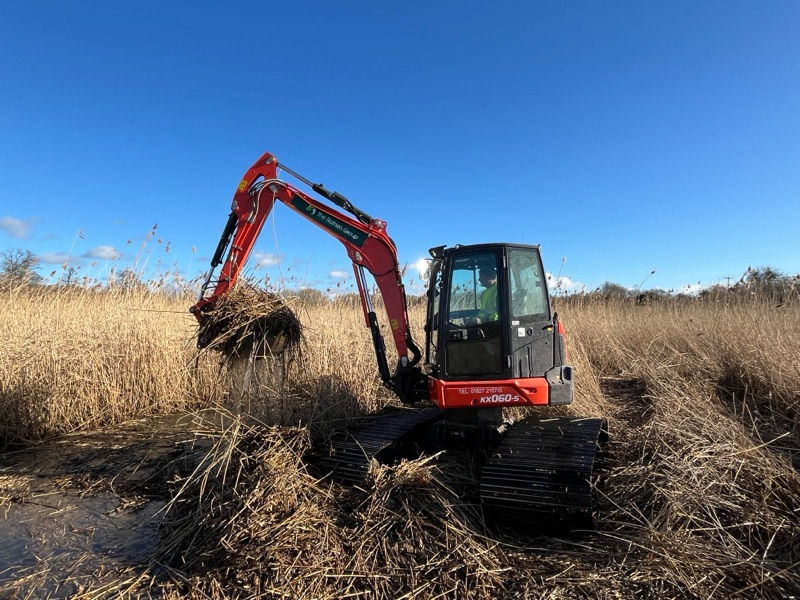
Waterway Maintenance
Healthy waterways don’t happen by accident.
We provide essential maintenance for canals, rivers, and reservoirs – above and below the waterline.
Waterway Maintenance Services
Our Specialist Waterway Maintenance Services
The nation’s canals, rivers, and reservoirs are more than just beautiful landscapes – they’re living infrastructure that requires constant care. The Rothen Group have looked after the UK’s waterways for decades, partnering with local authorities, private owners, and the Canal & River Trust to ensure these vital routes are flowing, accessible, and structurally sound.
If not properly maintained, everything falls into disrepair. From vegetation control and dredging to lock maintenance, bank repairs, and structural works, we provide complete, end-to-end solutions for common issues. Whether it’s scheduled upkeep or a reactive response, our skilled team of passionate engineers, technicians, and operators works to upgrade and repair damaged waterways.
We’re experts in everything from culvert cleaning to towpath resurfacing. Best of all, we clean up after ourselves, leaving each project as good as new.
Need help maintaining a canal, river or reservoir? Get in touch with The Rothen Group for expert guidance and a free site assessment.

Gallery

FEATURED CASE STUDY
Habitat Creation Coney Meadows, Droitwich
Coney Meadows is part of a nationwide project to restore the UK’s wetlands. Since the 17th century, large areas of reedbeds have been stripped and converted into agricultural land, massively reducing the number of habitats available for wetland animals.

FEATURED CASE STUDY
Changing the Shape of the River Derwent, Derby
Following the storm seasons of 2023 & 2024, the EA set out to review its impact on the UK’s waterways. The River Derwent in Derby was flagged after a sonar scan of its navigation identified a scour hole – a direct result of heavy rainfall pushing sediment downstream.
The UK’s waterways are still functioning and open due to the care and attention of generations of passionate individuals and organisations. We’re one of them! If left unrepaired, banks would collapse, silt would accumulate, and nature would overwhelm sites.
Waterway maintenance involves everything from waterway dredging and vegetation control to towpath repairs, lock gate servicing, and culvert clearing. It’s about viewing the waterway holistically, taking the necessary action to maintain flow, safety, and long-term integrity.
It’s a lot easier to maintain and repair what works than it is to restore what doesn’t – and a lot cheaper. We encourage all responsible organisations to look after their waterways.
What is waterway maintenance?
Without ongoing care, waterways can quickly degrade – with issues like silt build-up, bank erosion, and blocked culverts disrupting flow and access. This impacts everyone who relies on these waterways for recreation or work.
Canals and rivers serve as important arteries within the UK for transportation, while reservoirs collect water for drinking or to hydrologically manage the landscape. With our waterway repairs, we prevent structural failures, protect biodiversity, and ensure the UK’s marine infrastructure is fit for future generations.
Why does waterway maintenance matter?
Most forms of waterway maintenance are focused on what’s above the water, including culverts, banks, and locks. However, what’s below the surface is equally important. Silt, debris, and sediment gradually accumulate in our waterways, blocking the flow of water and making sections impassable. This can have catastrophic effects, increasing the risk of flooding and preventing navigation.
Waterway dredging removes the accumulated material, restoring water depth, reducing flood risk, and ensuring people can travel along the river or canal safely. While other maintenance focuses on surface or structural elements, dredging targets the water body itself to keep it flowing freely.
How is waterway dredging different from other maintenance?
Maintenance and restoration aren’t the same. Maintenance looks after what’s already working; restoration brings neglected or failing waterways back into use.
Waterway maintenance involves ongoing work to preserve function and prevent deterioration. It’s usually performed every few months or years and is very cost-effective.
Waterway restoration occurs when a canal or river is in a state of disrepair. It requires bringing the waterway back into working order, often involving more intensive structural and environmental work.
We always recommend maintenance over restoration – it’s simply easier. Moreover, if a waterway has been restored, it’s crucial to maintain it going forward.
What’s the difference between waterway maintenance and restoration?
You might think that rivers maintain themselves. To some extent, that’s true. But rivers don’t stay functional without the right assistance. The Rothen Group manages vegetation, trimming back unwieldy bushes and trees, maintains bank stability, clears blockages, and repairs riparian assets to control the water flow, prevent flooding, and protect habitats.
It’s part of being responsible and keeping the wider water network safe and sustainable. We’re proud to do our bit.
How does waterway maintenance support river management?
FAQ
Your Questions Answered
contract services
Related services
about us
A decade of
The Rothen Group
Waterways don’t maintain themselves — and without proper care, small issues quickly become major problems. The Rothen Group specialises in keeping the UK’s canals, rivers and reservoirs functioning safely through practical, proactive waterway maintenance.
Whether it’s a silted channel, a damaged culvert, or a worn towpath, we step in with the right tools, techniques and know-how to put things right. Our team of engineers, project managers, and operators help control water flow, protect vital infrastructure, and ensure that these essential corridors remain open, safe and sustainable for the communities and ecosystems that rely on them.












